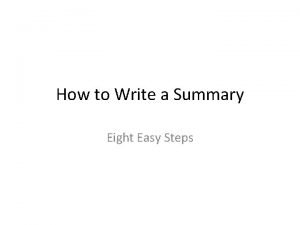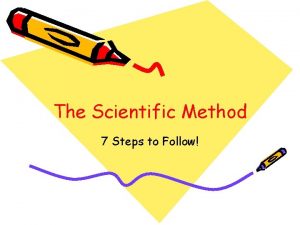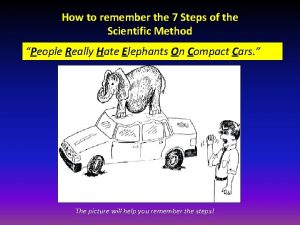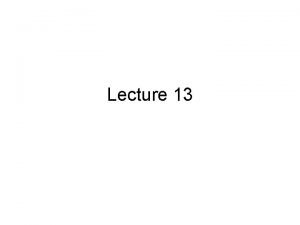HOW TO WRITE A SUMMARY THE SEVEN STEPS






- Slides: 6

HOW TO WRITE A SUMMARY THE SEVEN STEPS OF A SUMMARY

Summary A summary is a shortened version of a text. It contains the main points in the text and is written in your own words. It is a mixture of reducing a long text to a short text and selecting relevant information. Summarising is useful when you are using the work of others to support your own view. A good summary shows that you have understood the text. Please remember, though, that even when you summarise someone's work, you must acknowledge it. Ex: Source Summary The amphibia, which is the The first animals to leave the animal class to which our frogs sea and live on dry land were and toads belong, were the amphibia. first animals to crawl from the sea and inhabit the earth.

THE SEVEN STEPS OF A SUMMARY

1) Read and understand the text carefully 2)Think about the purpose of the text a. Ask what the author's purpose is in writing the text? b. What is your purpose in writing your summary? c. Are you summarising to support your points? d. Or are you summarising so you can criticise the work before you introduce your main points? 3) Select the relevant information. This depends on your purpose. 4) Find the main ideas - what is important. a. They may be found in topic sentences. b. Distinguish between main and subsidiary information. c. Delete most details and examples, unimportant information, anecdotes, examples, illustrations, data etc. d. Find alternative words/synonyms for these words/phrases - do not change specialised vocabulary and common words.

5. Change the structure of the text. a. Identify the meaning relationships between the words/ideas - e. g. cause/effect, generalisation, contrast. Express these relationships in a different way. b. Change the grammar of the text: rearrange words and sentences. Change nouns to verbs, adjectives to adverbs, etc. , break up long sentences, combine short sentences. c. Simplify the text. Reduce complex sentences to simple sentences, simple sentences to phrases, phrases to single words. 6. Rewrite the main ideas in complete sentences. Combine your notes into a piece of continuous writing. Use conjunctions and adverbs such as 'therefore', 'however', 'although', 'since', to show the connections between the ideas.

7. Check your work. a. Make sure your purpose is clear. b. Make sure the meaning is the same. Distinguish between main and subsidiary information. Delete most details and examples, unimportant information, anecdotes, examples, illustrations, data etc. Simplify the text. c. Make sure the style is your own. d. Remember to acknowledge other people's work.










